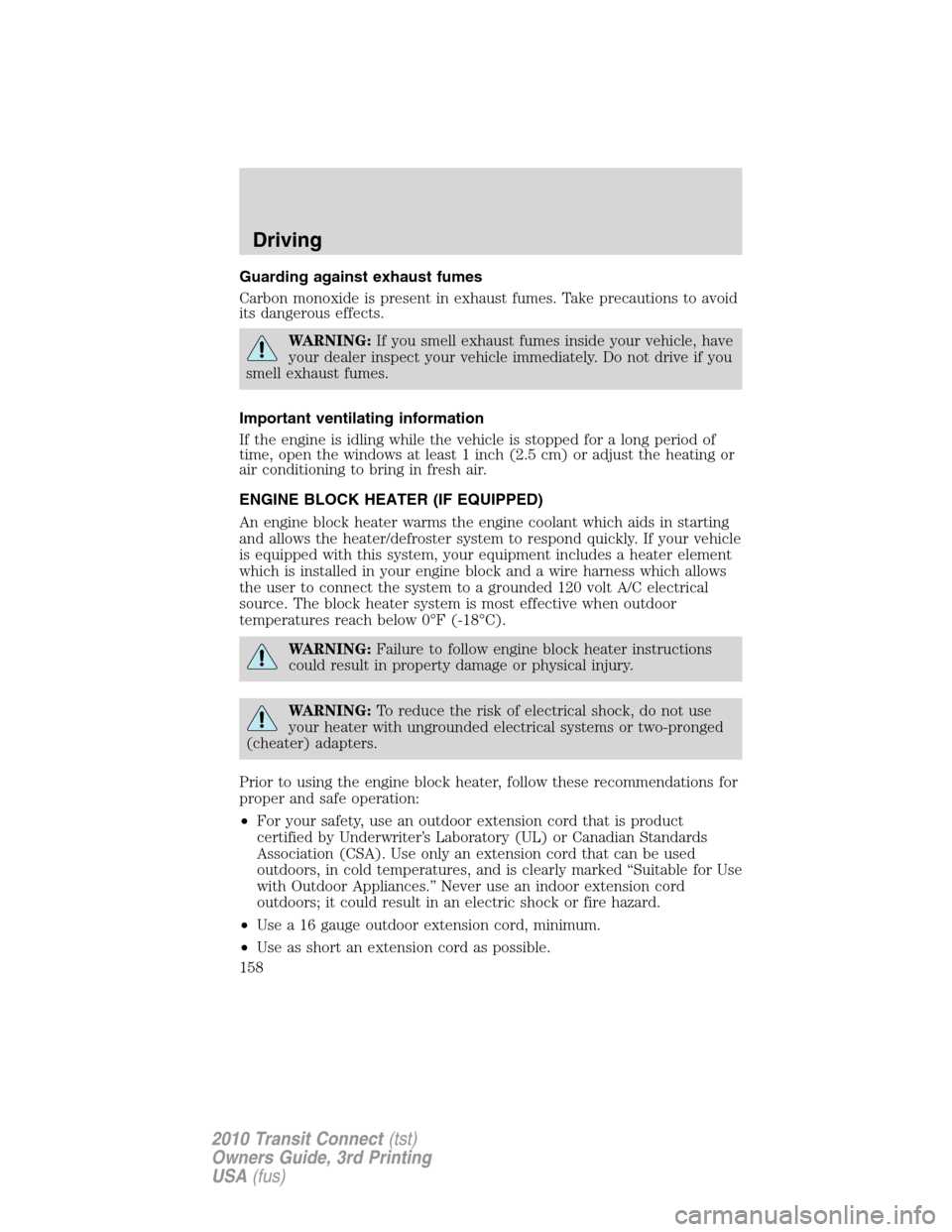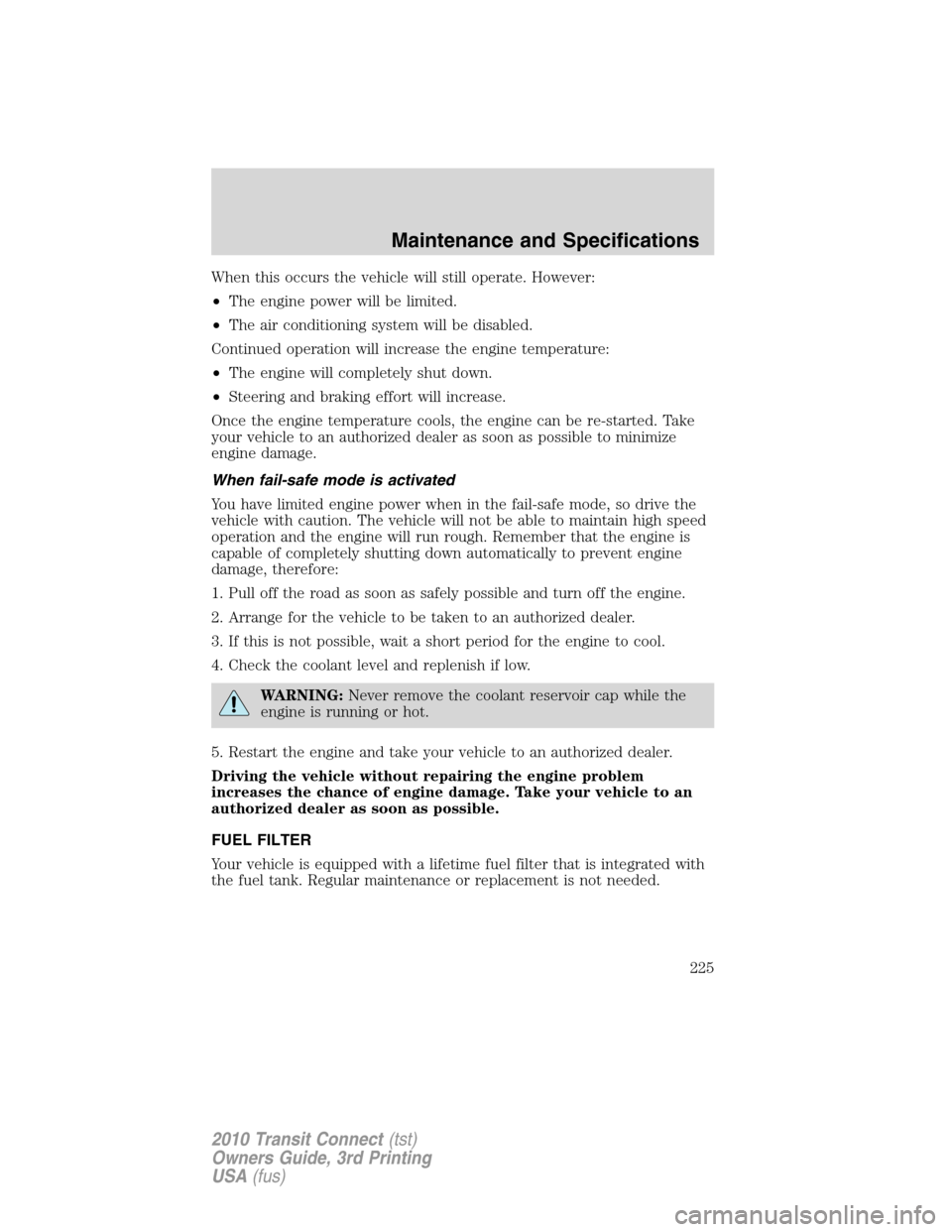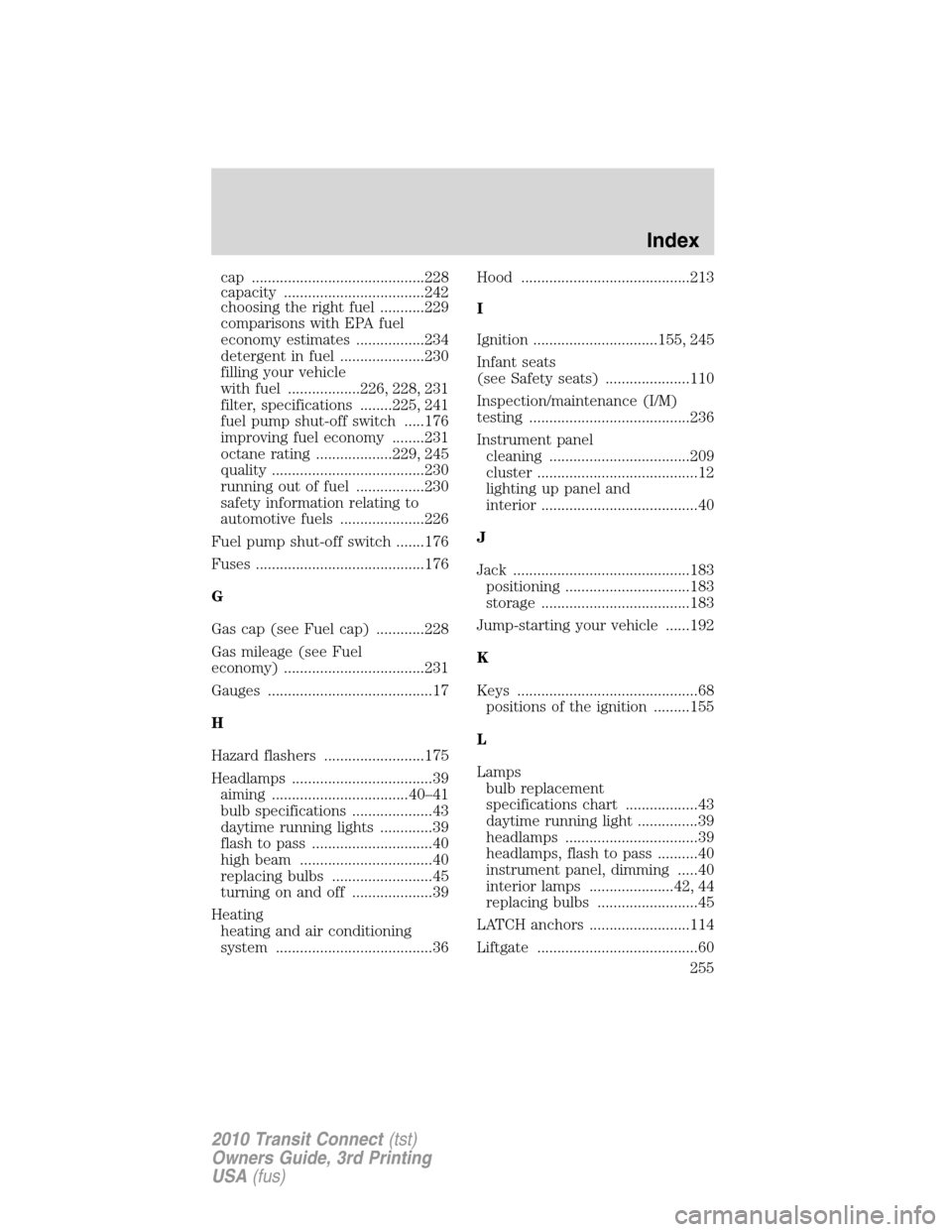air conditioning FORD TRANSIT CONNECT 2010 1.G Owners Manual
[x] Cancel search | Manufacturer: FORD, Model Year: 2010, Model line: TRANSIT CONNECT, Model: FORD TRANSIT CONNECT 2010 1.GPages: 258, PDF Size: 1.98 MB
Page 1 of 258

Introduction 4
Instrument Cluster 12
Warning lights and chimes 12
Gauges 17
Entertainment Systems 20
AM/FM stereo 20
AM/FM stereo with CD 21
Auxiliary input jack (Line in) 24
Bluetooth system 25
Climate Controls 36
Manual heating and air conditioning 36
Rear window defroster 38
Lights 39
Headlamps 39
Turn signal control 42
Bulb replacement 43
Driver Controls 51
Windshield wiper/washer control 51
Steering wheel adjustment 52
Power windows 54
Mirrors 55
Speed control 56
Locks and Security 62
Keys 62
Anti-theft system 67
Table of Contents
1
2010 Transit Connect(tst)
Owners Guide, 3rd Printing
USA(fus)
Page 36 of 258

MANUAL HEATING AND AIR CONDITIONING SYSTEM
1.Temperature control:Controls the temperature of the airflow in the
vehicle. For optimum defrosting performance, set the dial to the defrost
symbol
.
2.Air flow selections:Controls the direction of the airflow in the
vehicle. See the following for a brief description on each control setting:
:Distributes air through the instrument panel vents.
:Distributes air through the instrument panel vents and floor vents.
:Distributes air through the floor vents.Note:You may notice a
small amount of air flowing from the demister and defroster vents.
:Distributes air through the windshield defroster vents, demisters
and floor vents.
:Distributes outside air through the windshield defroster and
demister vents. Can be used to clear thin ice or fog from the windshield.
To exit
select another mode.
Climate Controls
36
2010 Transit Connect(tst)
Owners Guide, 3rd Printing
USA(fus)
Page 37 of 258

3.Fan speed adjustment:Controls the volume of air circulated in
the vehicle. For optimum defrosting performance, set the dial to at least
the 3 or 4 position near the
(defrost) symbol.
4.
Recirculated air:Press to activate/deactivate air recirculation
in the vehicle cabin. Recirculated air may reduce the amount of time
required to cool down the interior of the vehicle and may also help
reduce undesired odors from reaching the interior of the vehicle.
Recirculated air will not function in
(defrost).
5.A/C:Press to activate/deactivate air conditioning. Use with
recirculated air to improve cooling performance and efficiency. Engages
automatically in
(defrost).
Operating tips
•To reduce fog build up on the windshield during humid weather,
select
(defrost) and set the fan speed dial to the 3 or 4 position
near the
(defrost) symbol. Also, set the temperature setting to
the defrost symbol
during cooler weather.
•To reduce humidity build up inside the vehicle, do not drive with the
system off or with
(recirculated air) engaged and A/C off.
•Do not put objects under the front seats that will interfere with the
airflow to the back seats.
•Remove any snow, ice or leaves from the air intake area at the base of
the windshield.
•To improve the time to reach comfort in hot weather, drive with the
windows slightly open for 2-3 minutes after start up or until the
vehicle has been “aired out.”
During extreme high ambient temperatures when idling stationary for
extended periods of time in gear, it is recommended to run the A/C in
the max A/C mode, reduce blower fan speed from the highest setting and
put the vehicle’s transmission into the P (Park) gear position to continue
to receive cool air from your A/C system.
For maximum cooling performance, select max A/C by doing the
following:
1. Select the coolest temperature setting.
2. Select recirculation air mode.
3. Set the fan to the highest speed initially. As the interior starts to cool
down, adjust the fan speed to maintain comfort and/or switch from
recirculated air to outside air mode.
Climate Controls
37
2010 Transit Connect(tst)
Owners Guide, 3rd Printing
USA(fus)
Page 158 of 258

Guarding against exhaust fumes
Carbon monoxide is present in exhaust fumes. Take precautions to avoid
its dangerous effects.
WARNING:If you smell exhaust fumes inside your vehicle, have
your dealer inspect your vehicle immediately. Do not drive if you
smell exhaust fumes.
Important ventilating information
If the engine is idling while the vehicle is stopped for a long period of
time, open the windows at least 1 inch (2.5 cm) or adjust the heating or
air conditioning to bring in fresh air.
ENGINE BLOCK HEATER (IF EQUIPPED)
An engine block heater warms the engine coolant which aids in starting
and allows the heater/defroster system to respond quickly. If your vehicle
is equipped with this system, your equipment includes a heater element
which is installed in your engine block and a wire harness which allows
the user to connect the system to a grounded 120 volt A/C electrical
source. The block heater system is most effective when outdoor
temperatures reach below 0°F (-18°C).
WARNING:Failure to follow engine block heater instructions
could result in property damage or physical injury.
WARNING:To reduce the risk of electrical shock, do not use
your heater with ungrounded electrical systems or two-pronged
(cheater) adapters.
Prior to using the engine block heater, follow these recommendations for
proper and safe operation:
•For your safety, use an outdoor extension cord that is product
certified by Underwriter’s Laboratory (UL) or Canadian Standards
Association (CSA). Use only an extension cord that can be used
outdoors, in cold temperatures, and is clearly marked “Suitable for Use
with Outdoor Appliances.” Never use an indoor extension cord
outdoors; it could result in an electric shock or fire hazard.
•Use a 16 gauge outdoor extension cord, minimum.
•Use as short an extension cord as possible.
Driving
158
2010 Transit Connect(tst)
Owners Guide, 3rd Printing
USA(fus)
Page 225 of 258

When this occurs the vehicle will still operate. However:
•The engine power will be limited.
•The air conditioning system will be disabled.
Continued operation will increase the engine temperature:
•The engine will completely shut down.
•Steering and braking effort will increase.
Once the engine temperature cools, the engine can be re-started. Take
your vehicle to an authorized dealer as soon as possible to minimize
engine damage.
When fail-safe mode is activated
You have limited engine power when in the fail-safe mode, so drive the
vehicle with caution. The vehicle will not be able to maintain high speed
operation and the engine will run rough. Remember that the engine is
capable of completely shutting down automatically to prevent engine
damage, therefore:
1. Pull off the road as soon as safely possible and turn off the engine.
2. Arrange for the vehicle to be taken to an authorized dealer.
3. If this is not possible, wait a short period for the engine to cool.
4. Check the coolant level and replenish if low.
WARNING:Never remove the coolant reservoir cap while the
engine is running or hot.
5. Restart the engine and take your vehicle to an authorized dealer.
Driving the vehicle without repairing the engine problem
increases the chance of engine damage. Take your vehicle to an
authorized dealer as soon as possible.
FUEL FILTER
Your vehicle is equipped with a lifetime fuel filter that is integrated with
the fuel tank. Regular maintenance or replacement is not needed.
Maintenance and Specifications
225
2010 Transit Connect(tst)
Owners Guide, 3rd Printing
USA(fus)
Page 255 of 258

cap ...........................................228
capacity ...................................242
choosing the right fuel ...........229
comparisons with EPA fuel
economy estimates .................234
detergent in fuel .....................230
filling your vehicle
with fuel ..................226, 228, 231
filter, specifications ........225, 241
fuel pump shut-off switch .....176
improving fuel economy ........231
octane rating ...................229, 245
quality ......................................230
running out of fuel .................230
safety information relating to
automotive fuels .....................226
Fuel pump shut-off switch .......176
Fuses ..........................................176
G
Gas cap (see Fuel cap) ............228
Gas mileage (see Fuel
economy) ...................................231
Gauges .........................................17
H
Hazard flashers .........................175
Headlamps ...................................39
aiming ..................................40–41
bulb specifications ....................43
daytime running lights .............39
flash to pass ..............................40
high beam .................................40
replacing bulbs .........................45
turning on and off ....................39
Heating
heating and air conditioning
system .......................................36Hood ..........................................213
I
Ignition ...............................155, 245
Infant seats
(see Safety seats) .....................110
Inspection/maintenance (I/M)
testing ........................................236
Instrument panel
cleaning ...................................209
cluster ........................................12
lighting up panel and
interior .......................................40
J
Jack ............................................183
positioning ...............................183
storage .....................................183
Jump-starting your vehicle ......192
K
Keys .............................................68
positions of the ignition .........155
L
Lamps
bulb replacement
specifications chart ..................43
daytime running light ...............39
headlamps .................................39
headlamps, flash to pass ..........40
instrument panel, dimming .....40
interior lamps .....................42, 44
replacing bulbs .........................45
LATCH anchors .........................114
Liftgate ........................................60
Index
255
2010 Transit Connect(tst)
Owners Guide, 3rd Printing
USA(fus)